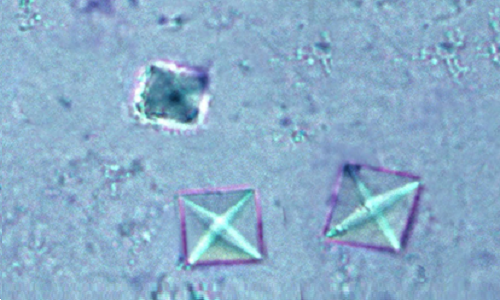Practice Scenario

Meet SOPHIE
A 5-year-old, spayed-female, mixed-breed cat
- Sophie is in hospital today for a routine wellness examination. Her body condition score is 5/9, which is consistent with previous visits.
- Although Sophie has always been healthy, her owner is concerned about Sophie’s risk for lower urinary tract disease.
- Sophie is an indoor-only cat that eats mostly dry cat food, although she receives occasional treats of canned food.
Lower Urinary Tract Health
Feline Lower Urinary Tract Health: The Role of Diet
Maintenance of urinary tract health is important in cats. Studies report that between 3-5% of cats presented to veterinary clinics have feline lower urinary tract diseases (FLUTDs). FLUTDs are a group of diseases, including idiopathic cystitis, urolithiasis (urinary crystals and stones), and others, which affect the bladder and urethra. FLUTDs have many contributing factors, including stress, low water consumption, excess body weight, low levels of exercise, and confinement, and are prone to recur. Nutrition can be part of a multimodal strategy to maintain urinary tract health in cats.

Key Messages
- Healthy cats may benefit from eating a food formulated to help maintain urinary tract health by supporting a balanced urinary pH.
- Access to fresh, clean water should be ensured by cleaning water bowls and refreshing the water regularly. In multi-pet households, placement of water bowls should be avoided where cats may feel at risk of being attacked by another pet, e.g., in corners of rooms.
- Most healthy cats will consume sufficient quantities of water to maintain optimal hydration when eating solely dry foods and drinking water free-choice. However, if a cat is prone to lower urinary tract issues, it may be helpful to increase water intake by:
- Feeding wet diets or adding water to dry food.
- Providing different water sources (still water, moving water, e.g., a fountain) and using different containers (avoiding plastic) in case the pet has an individual preference.
- Providing a specially-formulated, nutrient-enriched, flavored water supplement.
- Resources that reduce stress and associated risk factors for FLUTDs should be provided, such as:
- Activity with toys and play sessions, including providing food in puzzle feeders, which can also help maintain ideal body condition and, possibly, decrease other risk factors.
- An adequate number of resources (e.g., food and water bowls, clean litter boxes, toys, space) in multi-pet households and easily accessible resources (e.g., a senior cat can comfortably climb into and out of the litter box).
To Share With Pet Owner:
Evaluating Your Cat’s Body Condition
Assess your cat's Body Condition in just 3 simple steps.
Additional Resources
Lulich, J. P., Berent, A. C., Adams, L. G., Westropp, J. L., Bartges, J. W., & Osborne, C. A. (2016). ACVIM small animal consensus recommendations on the treatment and prevention of uroliths in dogs and cats. Journal of Veterinary Internal Medicine, 30(5), 1564–1574. doi: 10.1111/jvim.14559
Queau, Y. (2019). Nutritional management of urolithiasis. Veterinary Clinics of North America: Small Animal Practice, 49, 175–186. doi: 10.1016/j.cvsm.2018.10.004
Sparkes, A. (2018). Understanding feline idiopathic cystitis. Vet Record, 182(17), 486. doi: 10.1136/vr.k1848
Hostutler, R. A., Chew, D. J., & DiBartola, S. P. (2005). Recent concepts in feline lower urinary tract disease. Veterinary Clinics of North America: Small Animal Practice, 35(1), 147–170, vii. doi: 10.1016/j.cvsm/2004.08.006
Tarttelin, M. F. (1987). Feline struvite urolithiasis: Factors affecting urine pH may be more important than magnesium levels in food. Veterinary Record, 121, 227.
